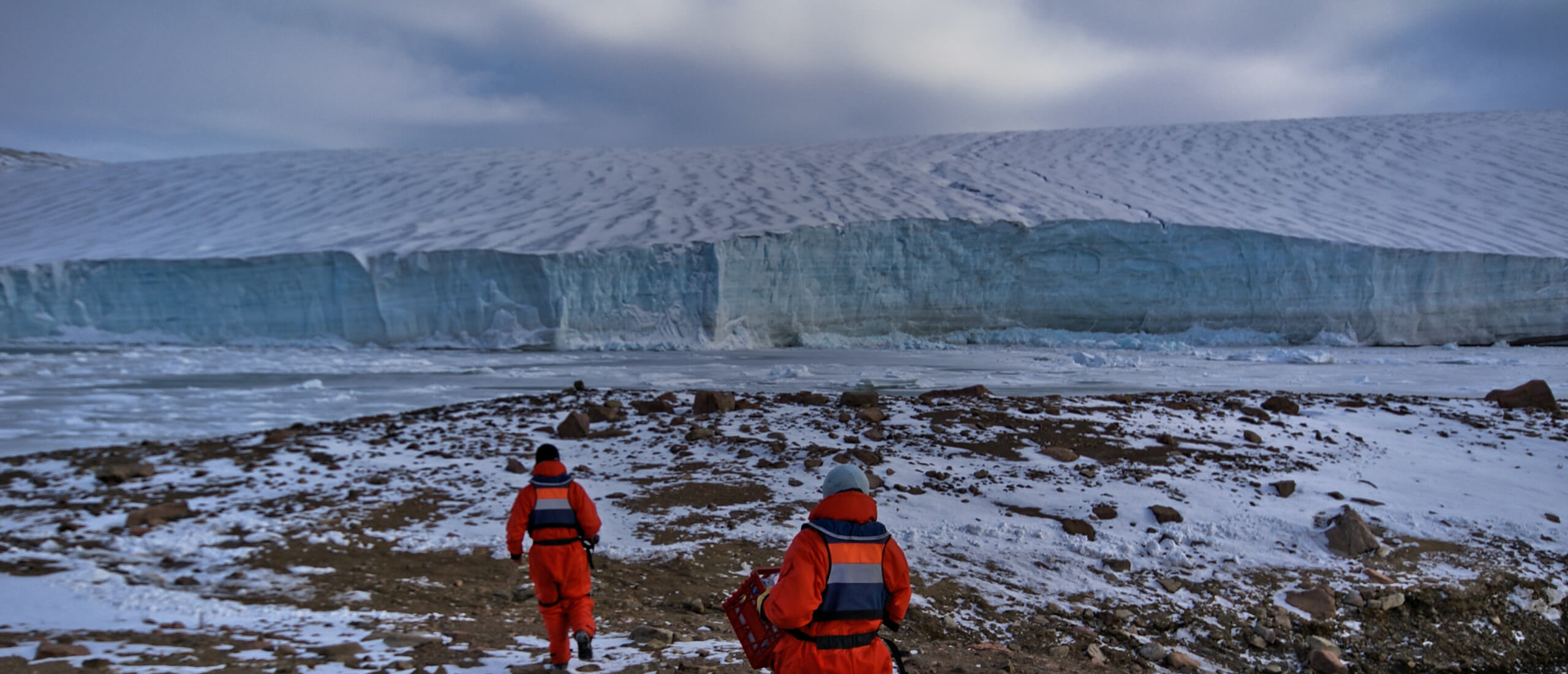Day 7 - The cryosphere as a cultural hub
March 8 - Report by Zoe Panchen, Anna Chesnokova, Gabriel Lachance, Noema Cox and Mick Appaqaq
Ullakkut! The last day of our trek was dedicated to ecology and community engagement – the natural closure of an action-packed week. Murray Humphries (McGill University) led the morning talks weaving ecology into food security and Inuit Qaujimajatuqangit (IQ). We were lucky to have guest speakers Jean Allen from Indigenous and Northern Affairs Canada with the Northern Contaminants Program, and Amy Caughey from the Government of Nunavut in the Health department to learn about different programs to address contaminants in the environment and in country food. Vicky Sahanatien from NWMB (Nunavut Wildlife Management Board) also gave a wonderful presentation on marine ecology which opened our eyes on the diversity of sea ice ecosystems.
The morning was followed by a sea ice excursion where Trevor Bell (Memorial University) demonstrated the SmartICE technology: we measured the sea ice thickness at 1.4 m, and then calibrated the equipment by measuring conductivity in a borehole nearby. The second part of the excursion consisted of an informal discussion with ETP students and Inuit hunters. We learnt about hunting and country food from their perspective, about how nutritious and essential it is for living in the Arctic, and its cultural value. We also learned about the importance of sea ice not only as an access to country food, but also as a part of the Inuit identity. This made us appreciate the cryosphere from a very different perspective.
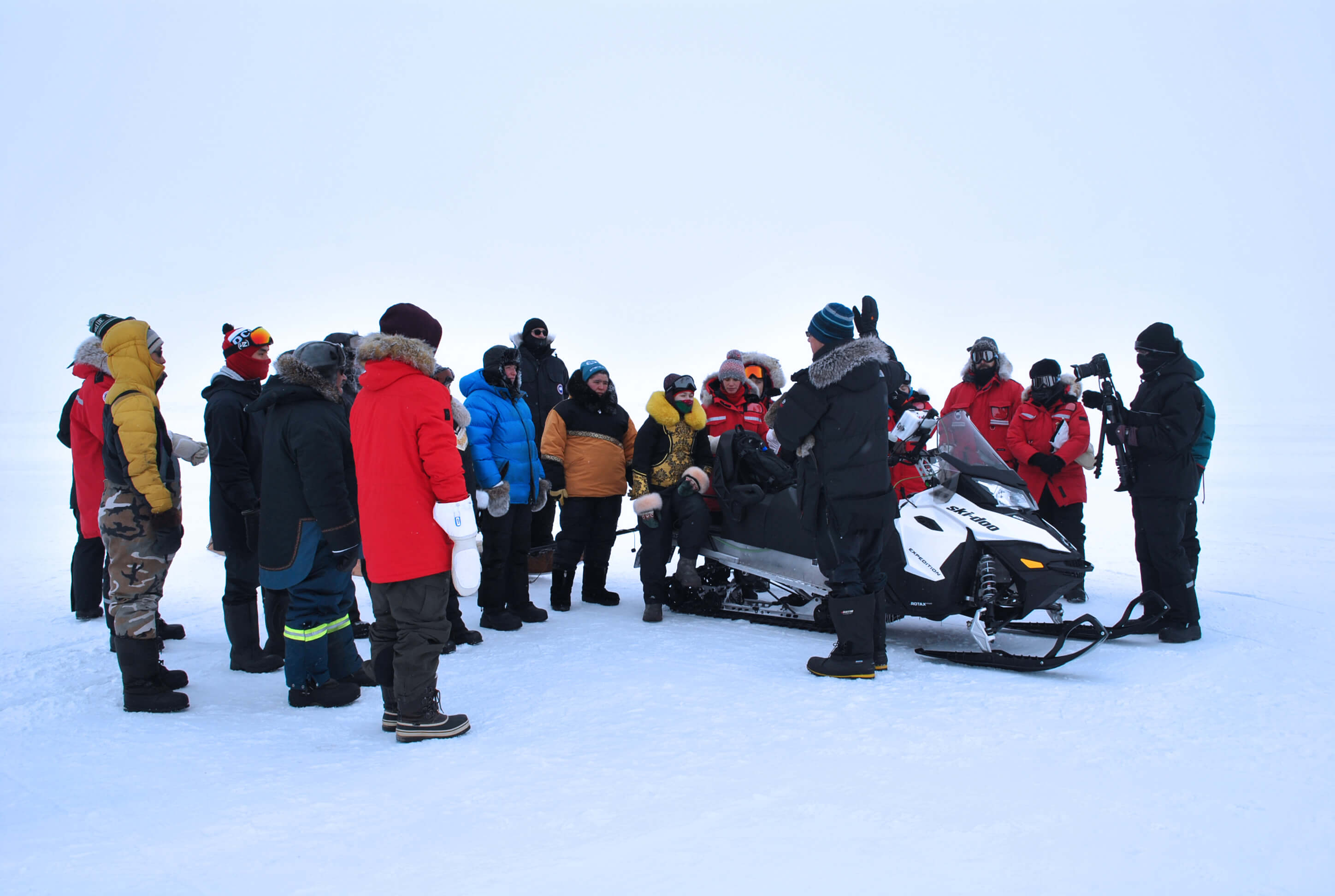
Sea ice excursion
The day was rounded out by dinner at the Discovery Boutique Hotel. Following the theme of the day we had Arctic char and caribou. The highlight of the day was the throat singing performed by Mary Itorcheak and Alashua Hanson from the Inuksuk High School choir, and Inuit games demonstrated by Johnny Issaluk. We then throat sang love songs to each other and tested each other’s strength by playing Inuit games. Thus, we learned about the necessity of being patient and creative in the Arctic and the togetherness of Inuit communities.
Photo: Zoe Panchen
Day 6 - The challenges of northern infrastructure (and a bit of music)
March 7 - Report by Justine Ramage, Georg Lackner, Carla Perez-Mon
The morning was as fresh and sunny as the previous ones. We started the day listening to the exciting 2-min research project presentation from Sarah, Jaqueline, Camille, Yukari and Jonathan. After this, Guy Doré (Universite Laval) introduced us to the challenges of building infrastructure on permafrost. How can one build a stable road on an unstable and thawing ground? We learned about solutions that engineers developed all over the Arctic to answer this crucial challenge here in the North. Have you ever thought that asphalt could be white or underlain with thermal pads to prevent the ground from thawing? Anne-Marie Leblanc (Natural Resources Canada – Geological Survey) gave us a concrete example on the recent renovation of the airport in Iqaluit. Good knowledge of ground ice and drainage patterns is essential to successfully build an infrastructure that will maintain the permafrost and thus allow a long-term usage.

Guy Doré speaking about the challenges of building infrastructure on permafrost
After a quick but tasty lunch, we visited the water plant of the city of Iqaluit. As the mayor explained a few days ago, water supply is a major challenge in a city built on permafrost. Burying water pipes is very costly and it disturbs the permafrost. The responsible of the water plant, Bob Brouillette, showed us the location of the lake and dam that supply fresh water to the city. The water is pumped from the lake, and then flows into pipes to the treatment plant. There, the water is filtered and stored in 5 billion liters water tanks. Some of this water go directly through pipes to the main buildings in the city. Most of the private houses have their own storage tanks, and get their water supply through trucks that deliver water on a daily basis. The system works very well and can provide water for the whole city during 1.5 days in case of power outrage. The main concern of the community is when pipes freeze and break. This is an issue that mostly happens at the beginning of spring and at the end of summer, when soil movement is at its peak.
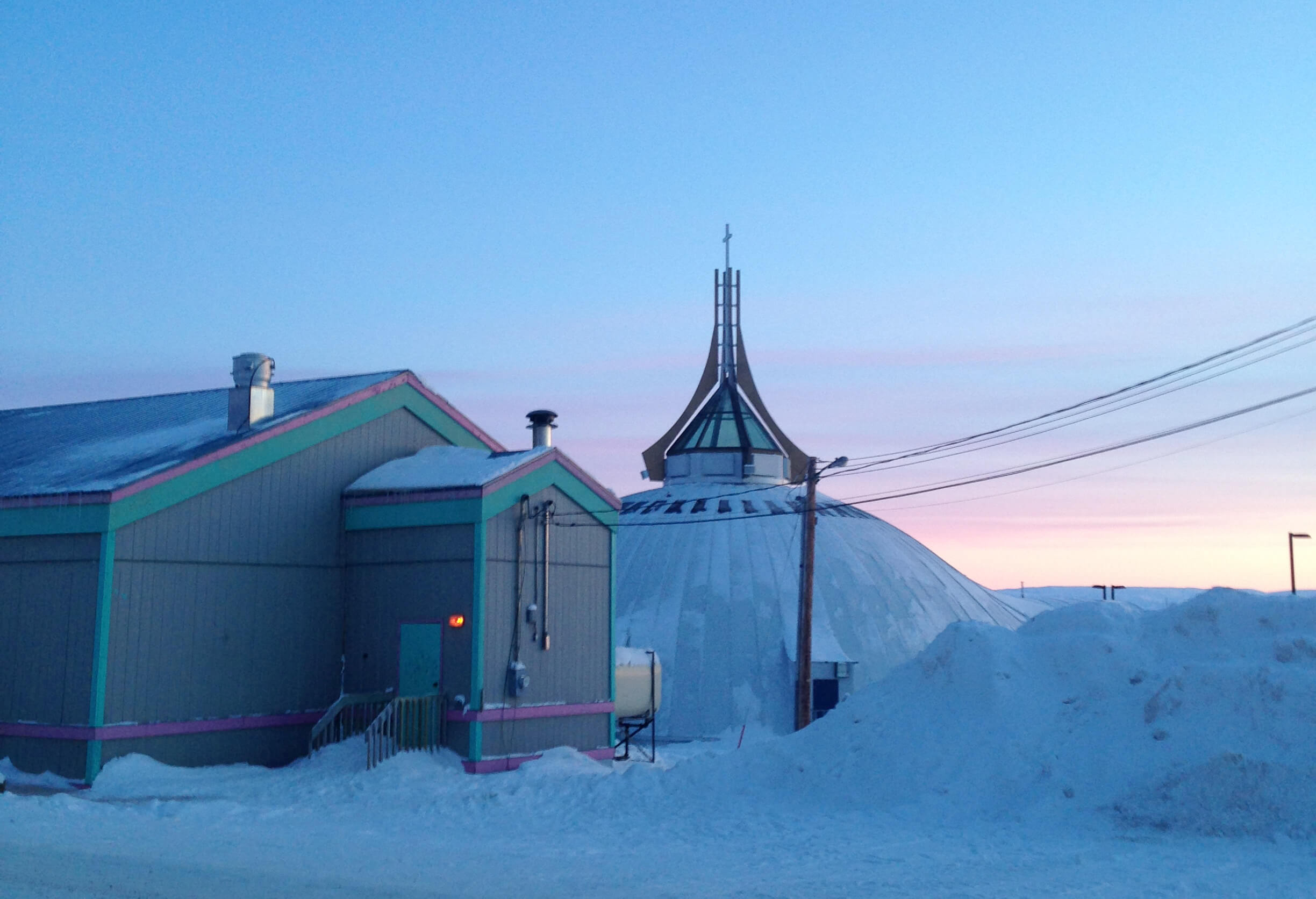
The water treatment plant and supply pipes of Iqaluit is a good example of infrastructure adapted to permafrost
During the rest of the afternoon we worked on our infrastructure projects. Our task is to find the best location to build a road along the airstrip in Iqaluit. To do so, we have to take into account many parameters such as surficial geology, drainage, prevailing winds and community needs. Most of this information can be found on very colorful maps, and we get the remaining information from our colleagues from the ETP who know the area very well.
Yet another exciting night! After wings night at the Storehouse Pub and Grill, most of us went to the francophone center of Iqaluit where they hold jam sessions every Wednesday night. We discovered very talented musicians from Iqaluit and also from our own group! Mick plays guitar and sings very beautiful songs. Felix and Christophe are very good guitarists and singers. Murray, Jonathan and Tommy improvised a band with basses and guitar and played lots of country and rock songs, Carla joined them with the harmonica. Many talented percussionists, such as Jean-Michel, supported their rhythms. Most of the songs were in English until Anna sang a soothing song in Russian. We were very impressed by the talent and energy from all musicians who contributed to this very relaxing evening!
Photos: J. Ramage
Day 5 - Hydrology in the rapidly changing north
March 6 - Report by Sappho Gilbert, Sarah Cooley and Christophe Perron
Today was hydrology day! First, we started with five 2-minute talks from our fellow IAFS students, all of which were related to cold-region hydrology and permafrost. In the morning, Jean-Michel Lemieux (Universite Laval) lectured on water resource options in northern regions. He talked about his research in communities located in Nunavik, Quebec, looking at different water sources and their vulnerabilities to climate change. More specifically, he talked about the limitations of surface water resources and some of the advantages and challenges associated with transitioning to groundwater in permafrost-impacted areas. After the coffee break, we broke out into our teams and completed a hydrology exercise in which we applied some of the theory gained in the lecture. We were given some hydrologic data from Umiujaq, Nunavik, and a batch of questions that had us thinking through the seasonality of catchment hydrology.

Fellow student Pierrick Lamontagne-Hallé presenting results of the Arctic hydrology team work
Our afternoon began with a brief introduction by Murray Richardson (Carleton University) on the metrics for small Arctic watersheds like the one we were on yesterday. We were then asked to split off again into our groups and work up some analysis of the data we collected while out on the lake yesterday afternoon. Our group was tasked with examining how the snow water equivalent, snow depth, and snow density vary along a topographic transect. After a quick break, each of the groups reported out their findings from their unique assignments. Great work, everyone!
We were then introduced to our next, two-day team project by Guy Doré (Universite Laval). The purpose of this project is to use topographic, surficial geologic, satellite image, and other maps to inform our design of a road from the southwest edge of town to the northern part of the tarmac at the new Iqaluit airport. We spent nearly an hour brainstorming our team’s approach to this challenge before heading off for our evening activities.
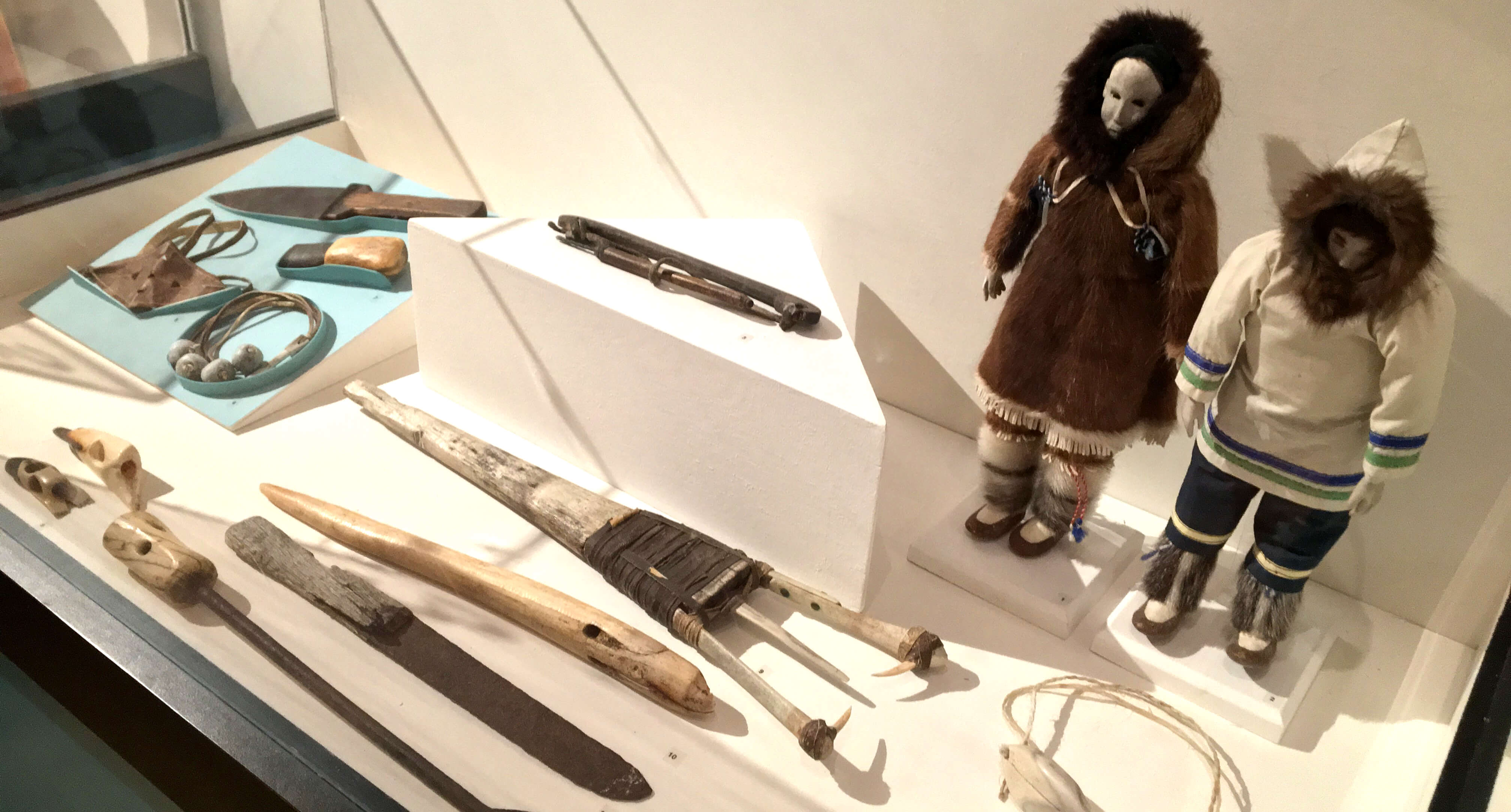
Museum in Iqaluit
We topped off our day with a night at the museum! The evening began with a brief introduction and tour of the permanent and other exhibitions, followed by some delicious, locally catered country foods (including whale and char… mmm!). We then heard from Margareta Johansson about INTER-ACT, a network of Arctic research stations. Finally, we circled up and shared about our experiences and opportunities for engaging local communities in our research – a fascinating discussion led by Trevor Bell (Memorial University) and Murray Humphries (McGill University).
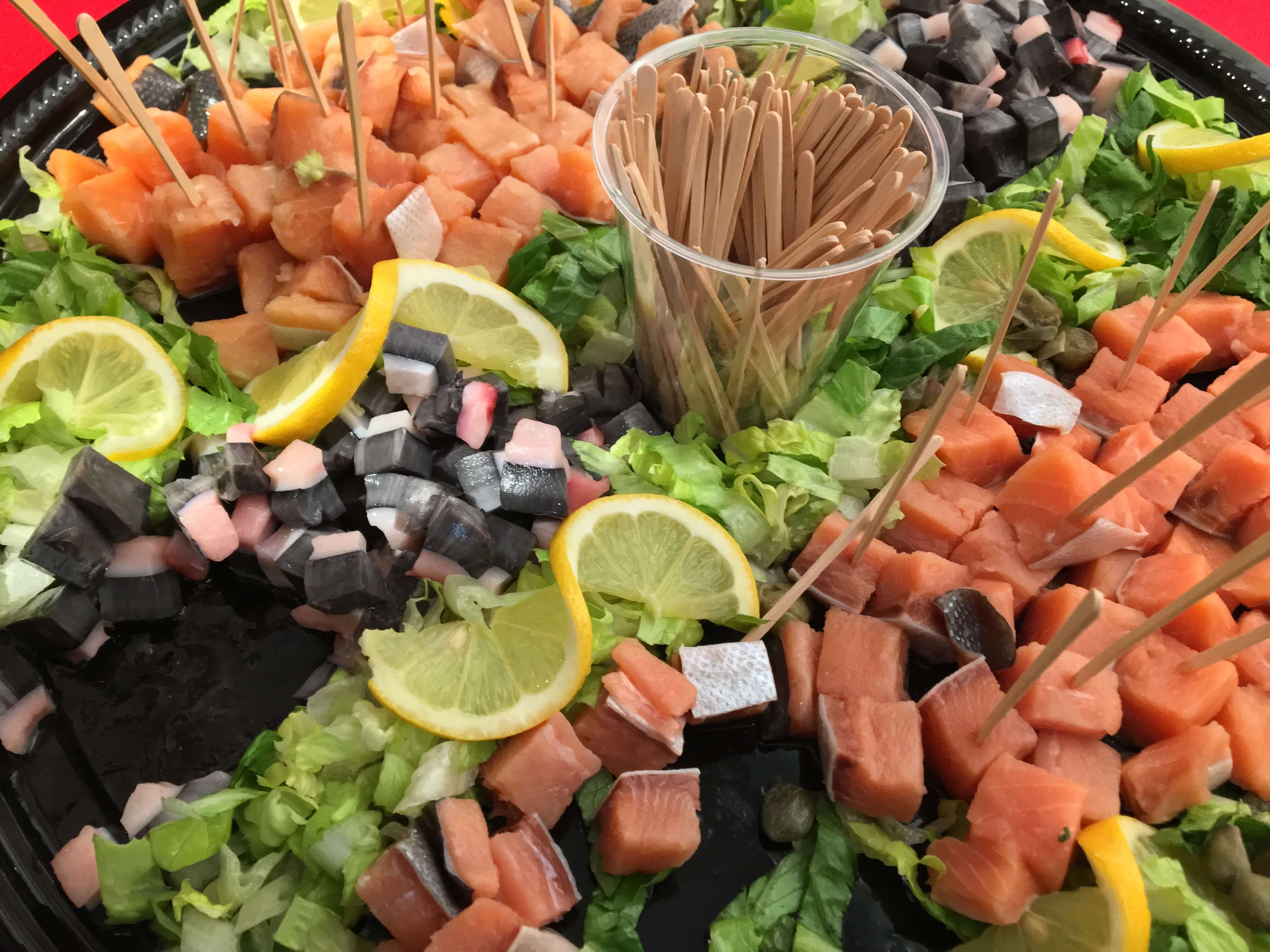
Northern country food platter of Arctic char and whale
In all, another rich, stimulating day at IAFS!
Photos: Sappho Gilbert
Day 4 - Permafrost, sensors and northern lights
March 5 - Report by Yukari Hori, Jacqueline Hung and Pierrick Lamontagne-Hallé (
Today was the start of the international students’ elevator pitches! We heard from 5 amazing presenters, who had 2 minutes each to tell us about their research. It was very interesting to see the breadth of transdisciplinary subjects that are being explored in the North.
Margareta Johansson (Lund University) then gave us an introduction to permafrost, including its effects on different Arctic features and processes, as well as the general distribution of permafrost regions around the world. These regions span terrestrial to marine environments in both polar regions. The discussion about the impacts of different environmental features on permafrost was very fruitful and sparked a lot of conversation about the ways that different elements influence permafrost, and how these might change under a warming climate.
Anne Marie Leblanc (permafrost geoscientist at Natural Resources Canada) took us through the geomorphological features of permafrost. It was interesting to note the importance of surficial geology on feature distribution. As polar regions warm up, it will be important to understand the different features and their spatial distribution in order to predict the effects they will have on the natural environment and neighbouring communities.
Keegan Smith (Global Water Futures, McMaster University) talked to us about blowing snow. By examining the physics of the movement of snow, we were able to make connections as to how the different snow features we see in the landscape form. Furthermore, it was fascinating to learn about the different ways we can observe snow and microclimate metamorphosis by examining different surficial features of blowing snow, like sastrugi.
Florent Domine (Université Laval) and our fellow IAFS student Georg Lackner put us through a snow and permafrost modelling exercise using Matlab software, where we used a conduction equation to examine the effects of freezing and thawing on heat exchange. Using the program written by Georg, we were able to model the effects of soil moisture and snow cover properties on ground temperatures on a sample tundra environment in Umiaq, Nunavik.
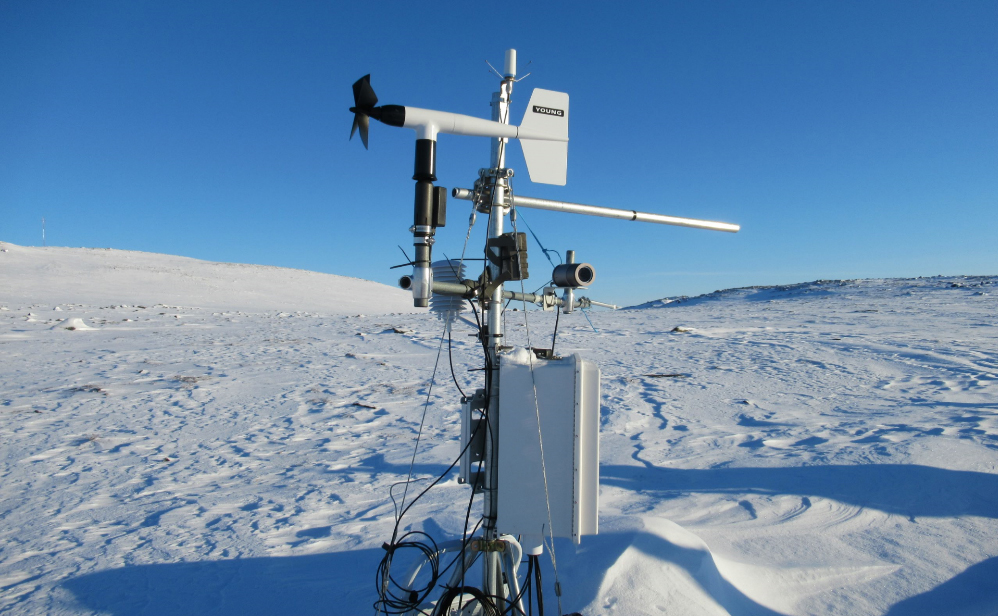
Meteorological station near Iqaluit (photo: Yukari Hori)
After a quick lunch, our field excursion of the day took us to “Lake 1”, where we had the opportunity to participate in snow survey transect, visit a meteorological station overseen by the Nunavut Research Institute, examine limnological sampling techniques, and test a light sensor prototype made by fellow student Gabriel Lachance to study photosynthesis under lake ice. Perhaps one of the most exciting parts of the excursion was being able to travel by snowmobile and qammatik to the field site on a beautiful day!
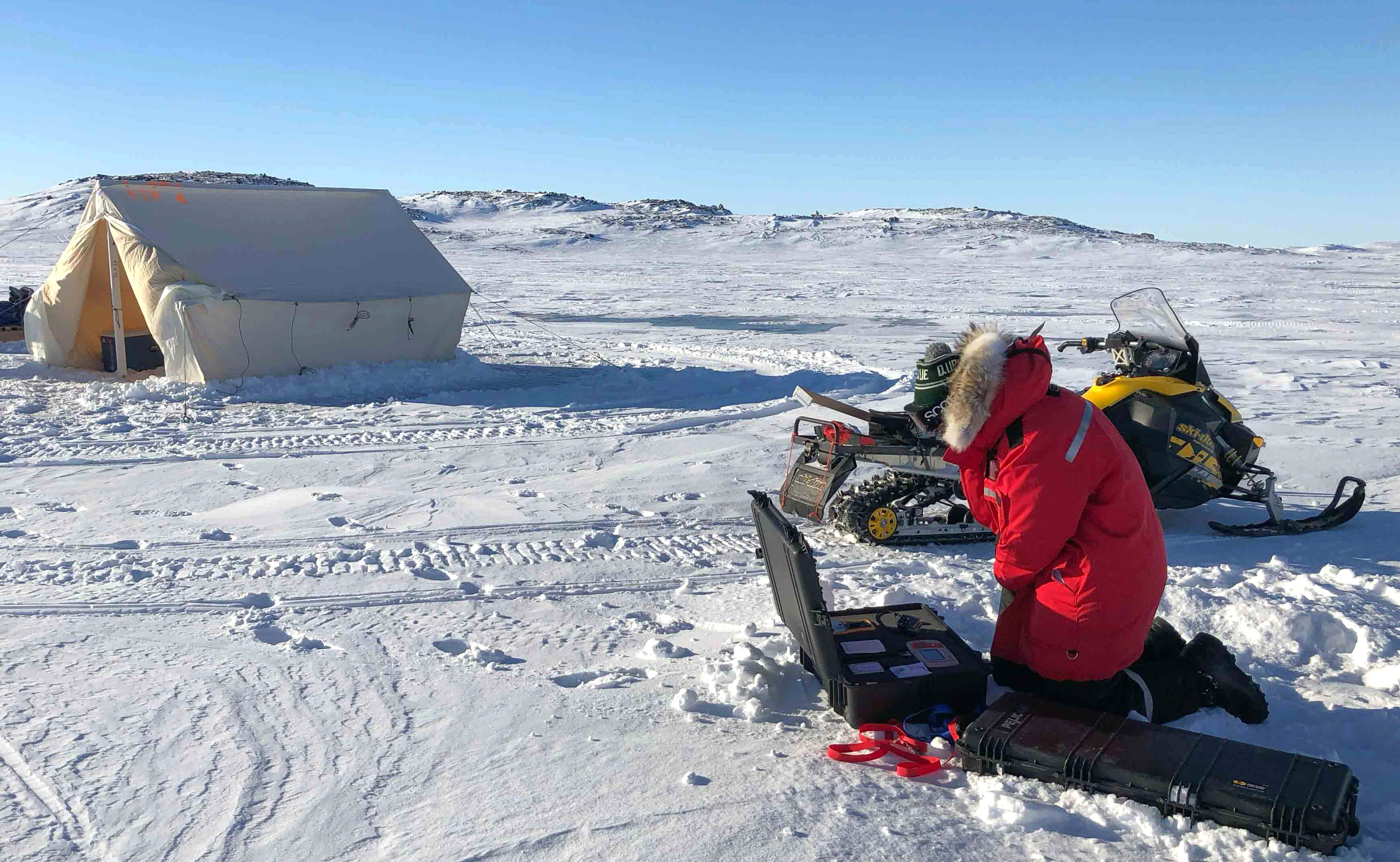
Deploying a light sensor to study photosynthesis under the ice
Last but not least, we finished our day with a viewing of the Northern Lights with Martine and Louis-Philippe from Inukpak Outfitting. They took us to two isolated spots in Iqaluit and Apex that were away from city lights. Combined with clear skies, little wind, and absolute darkness, we were treated to an amazing show of aurora borealis, which was a first for many of us in the group. The North is such a spectacular place, and the today’s evening outing was a great reminder why!
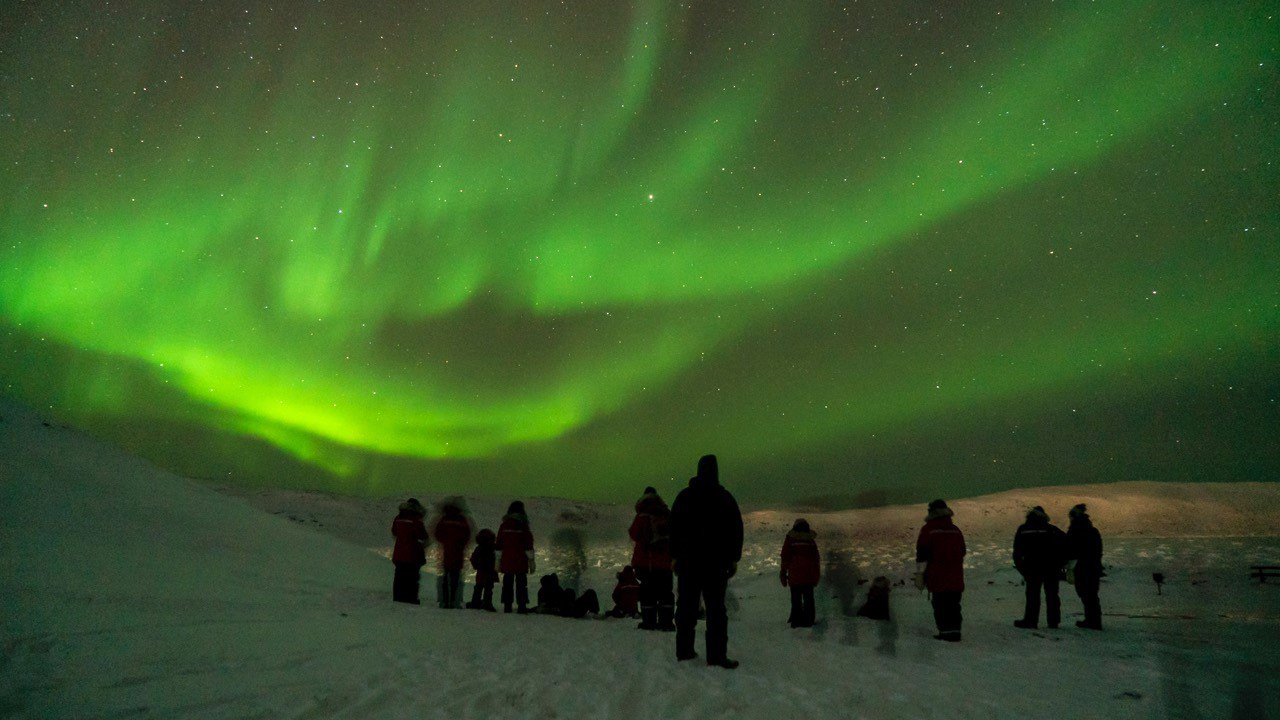
Northern lights near Iqaluit (Photo: J. Griffiths)
Day 3 - Of snow and northern research
March 4 - Report by Sarah Strand, Adrian Gustafson, Felix Lévesque-Desrosiers and Camille Escudé
The morning started with a beautiful view over Frobisher Bay and information on conducting research in the North from Jamal Shirley of the NRI. For successful research, early community involvement is key; ideally, the research plan is produced in tandem with the community and their needs. This will also help with the permitting process. The Environmental Technology Program (ETP) students shared their experiences in this area, and reiterated that researchers should plan with the community culture in mind (e.g. do not schedule a meeting on bingo night!).
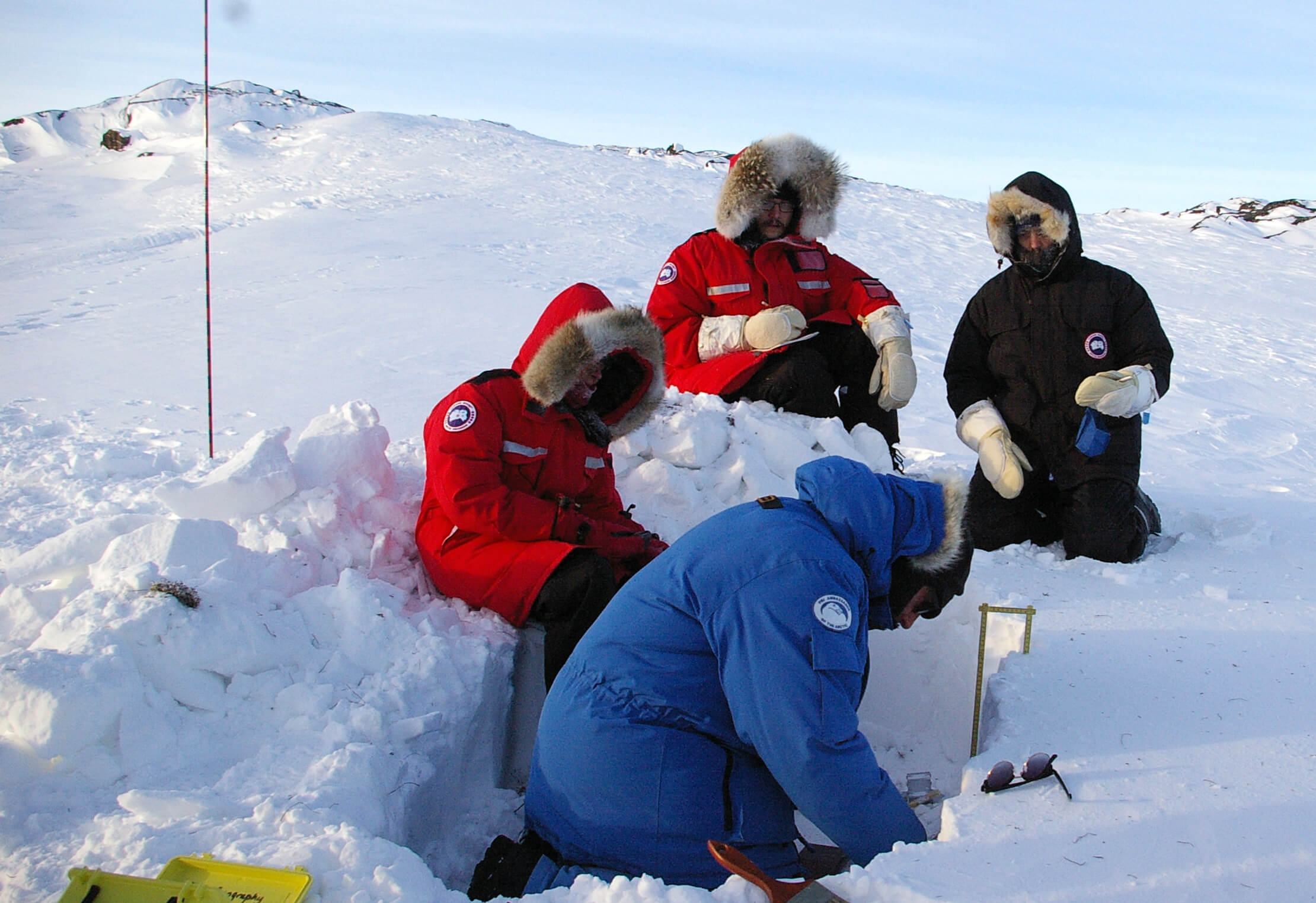
Collecting a block of snow to weigh, for determining its density
Next, we heard from Daniel Côté on optics and instrument design in the North. It became clear that transdisciplinarity helps in these areas, as challenges in neuroscience – like powering small and easily maneuverable sensors – are actually quite relatable to challenges when studying the cryosphere. Then Florent Dominé presented on snow metamorphism and Arctic snow packs. The last presentation of the morning was by Murray Richardson on variability in snow depth over the land, and how this impacts availability of water and the pollutants it can contain. These presentations provided a perfect introduction for the afternoon, which was spent in the snow.
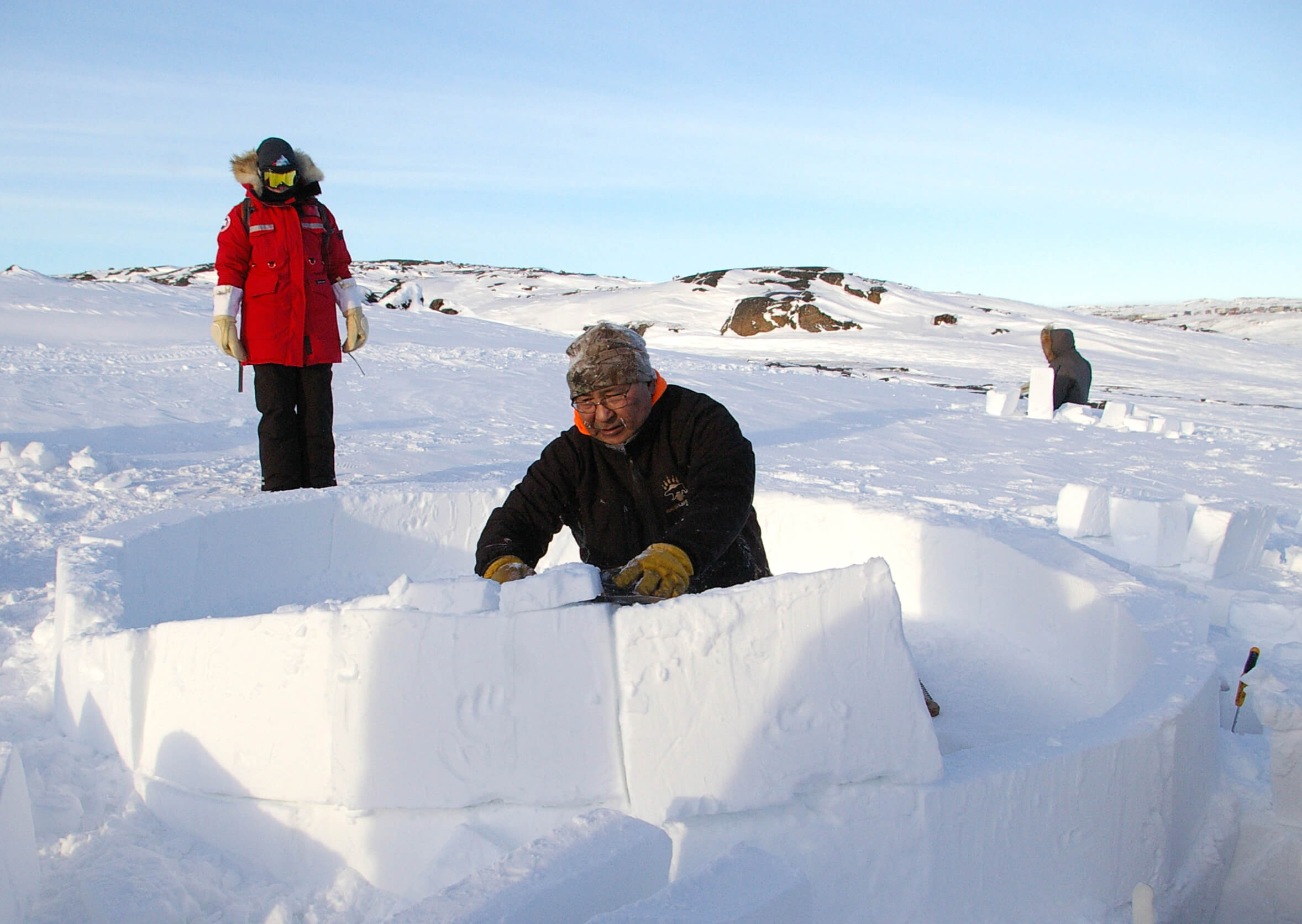
Solomon Awa, Igloo Master, showing the basics of igloo building
At Sylvia Grinnell Park, we dug snow pits, determined layering in the snow pack, and measured snow temperature. We were also able to observe different types of snow grains and snow layers, like depth hoar, which forms at the ground surface, and wind slabs in the central part of the snow pack. This exemplified the theory that we learned in the morning. After a snack of caribou soup and dried fish, everyone was able to try their hand at igloo building. This was the highlight of the day as we were able to learn a practical skill from a master igloo builder in the community. In this activity, the connection between science and traditional knowledge became clear. To saw the most solid snow blocks, it is best to use denser snow from wind slabs. Most people were also surprised to learn that igloos are built in a spiral, with left-handed people working in a clockwise direction, and right-handed people working in a counter-clockwise direction.
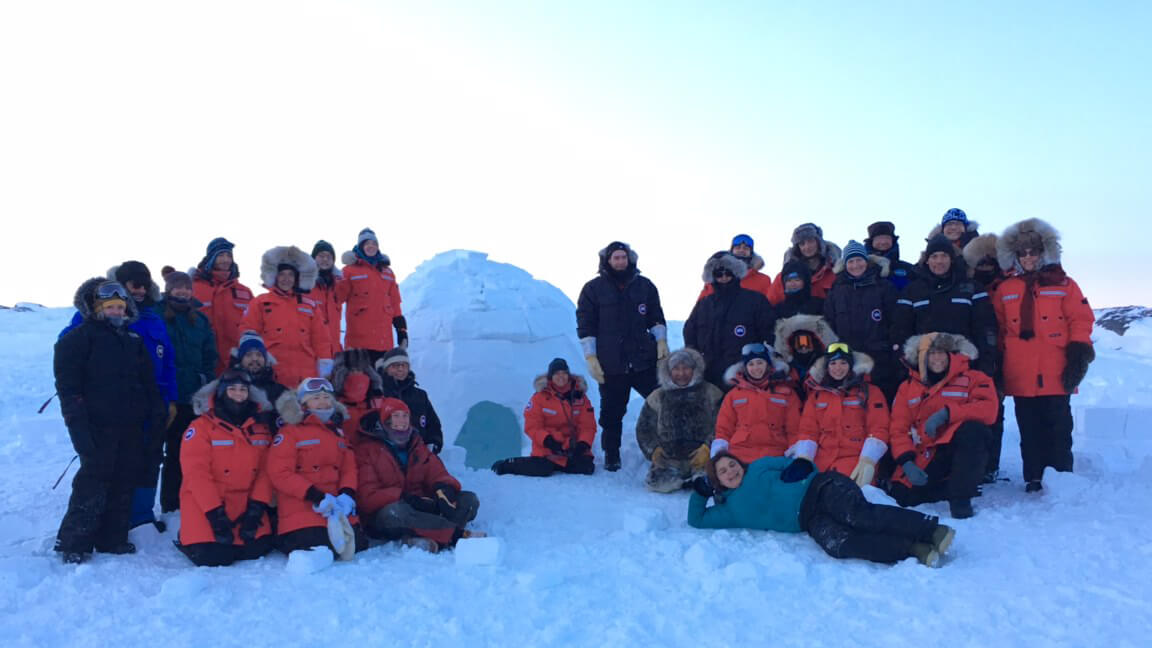
The day ended with two movies about research conducted with Inuit communities. These films highlighted the impact of globalization on the Inuit, and how research can be used to investigate and hopefully alleviate some of these issues. After the long day, we were tired but satisfied and excited about what we are learning.
Day 2 - Program kick off
March 3 - Report by Jonathan Raberg, Gillian Thiel, Sara Pedro
Today, Margareta Johansson from Lund University in Sweden and Jason Carpenter, the Senior Instructor for the Environmental Technology Program at the Nunavut Arctic College, introduced us to the main topic of the course: the changing cryosphere : why should we care?. It was clear that all of us were eager to learn and discuss this topic. The cryosphere is the “land of frozen water”, comprised by snow, sea ice, glaciers, ice sheets and permafrost. Due to climate change, the Arctic cryosphere is changing at a rate that doubles the global average. While the Arctic may seem remote to most of the world, it critically affects the global climate. Changes in the Arctic therefore have global implications.
Changes in the Arctic affect local communities more strongly. Jason Carpenter and Madeleine Redfern, the mayor of Iqaluit, talked about some of the major challenges the city is facing, as well as the remaining territory of Nunavut. The challenges include permafrost thawing and its effects on infrastructure, such as water pipes and building foundations, coastal erosion, and movements of invasive boreal species. As Arctic changes become increasingly apparent, how can Arctic communities shift from a reliance on traditional knowledge and adapt for the future?
In the afternoon we hopped on a school bus and toured around Iqaluit. The first stop was at the Inuit art shops, where we saw soapstone carvings of local wildlife, such as polar bears, walruses and seals. The local artists also sew beautiful seal and polar bear skin clothing, including mittens and boots. If not chemically treated, this clothing has to be kept in the fridge to prevent decomposition. Around 65% of the Iqaluit residents are artists, making this a largely important part of the local economy.
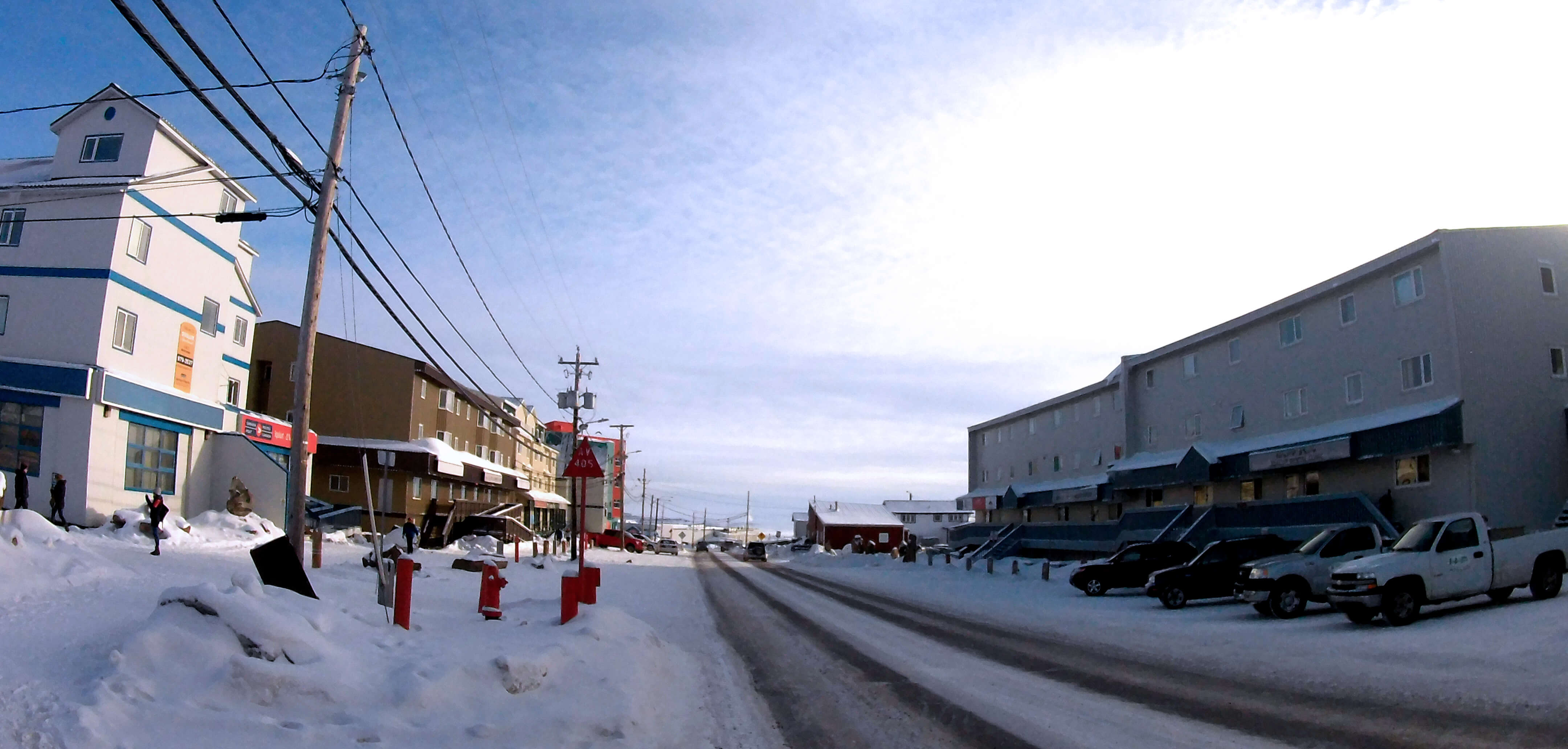
The town of Iqaluit
During the tour we also passed by the church, the schools, the elderly center, a few neighborhoods, the prison, the old fur trade buildings, and the visitors center. Schools are a growing necessity since the birth rate in Nunavut is the highest in Canada, with 3.1 children per woman compared to 1.2 in the southern part of the country. On the other side of the age spectrum, elders are valued members of the society, whose knowledge is held in high regard by the parliament. Although there is an elderly center in the city, most elders live at home with their families.
Our plans to spend the evening watching the northern lights outside the city were thwarted by a large cloud, but we are keeping our fingers crossed that the sky will clear up later in the week! Stay tuned for more news tomorrow when we’ll learn the basics of Arctic snow and put our skills to the test with igloo building.
Day 1 - Arrival in Iqaluit
March 2
Here we are now! After months of preparation, our group of 30 students and mentors with sharp expertise in northern science has finally arrived at its destination: Iqaluit, Nunavut. Despite the cold wind, everyone is happy and excited to begin this unique adventure. After meeting up with the rest of the team, composed of local experts and second-year Environmental Training Program (ETP) students from the Nunavut Arctic College (NAC), our delegation is complete and ready for our first assignment.
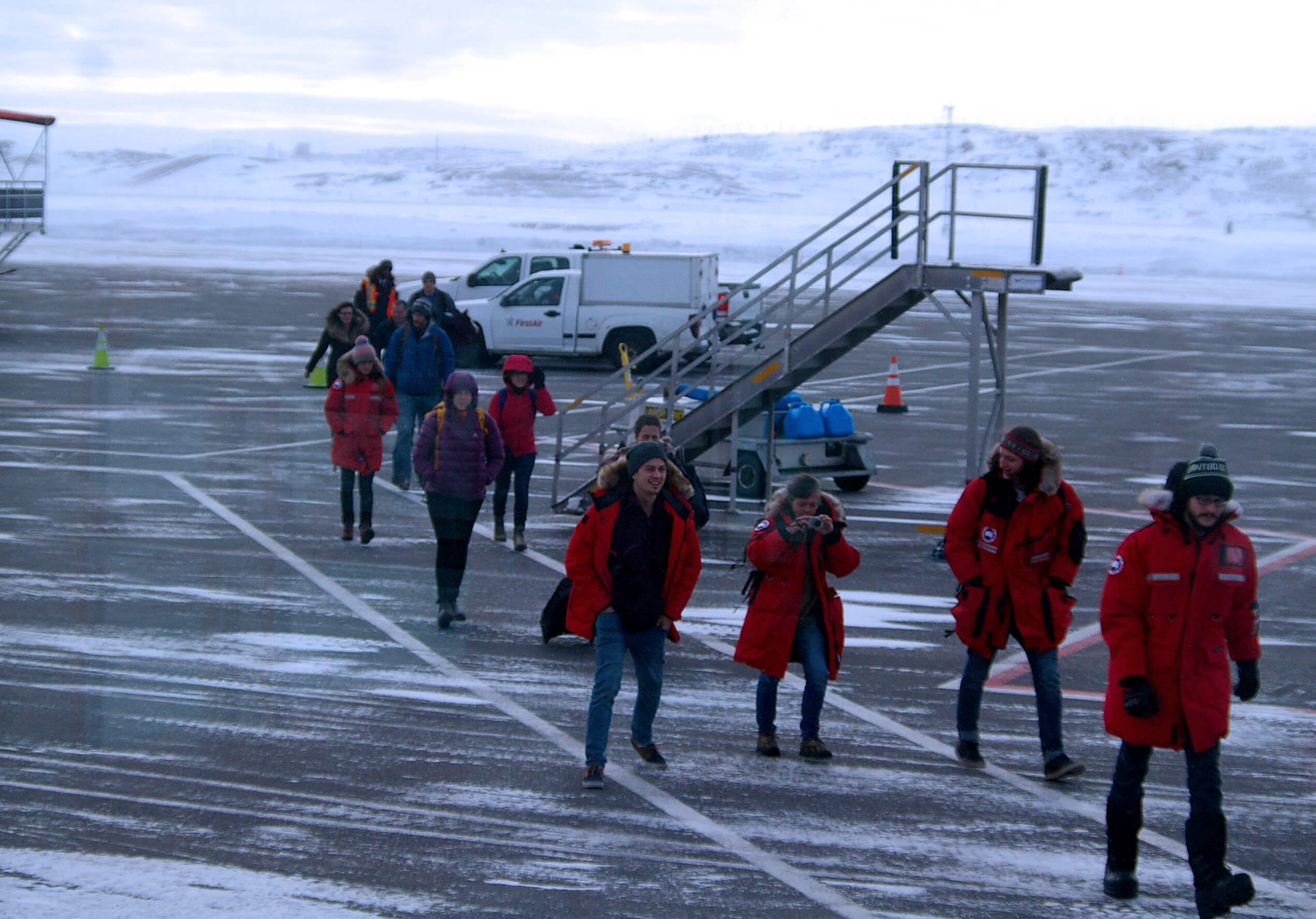
Arrival in Iqaluit
We were first invited to gather around an Inuit elder for the Qulliq ceremony, a traditional oil lighting device that once provided the sole source of warmth and light to dwellers of the Arctic. The elder explained why the Qulliq has been - and still is - important in Inuit culture. With tangible curiosity, we asked questions and experienced the Qulliq lighting with profound respect.
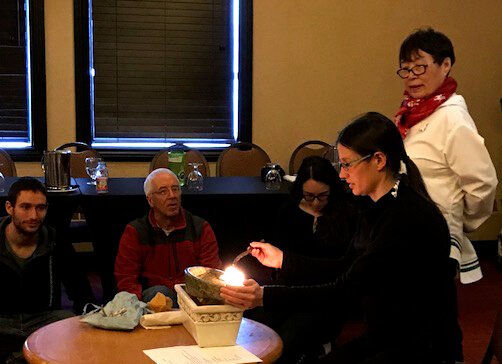
Inuit performing the Qulliq ceremony
The ceremony was followed by greetings from the mayor of Iqaluit, Madeleine Redfern, who insisted on the importance of getting to know her community. We discussed with her as she invited us to mingle with locals, a message echoed by Mary Ellen, director of the Nunavut Research Institute (NRI). Jamal Shirley, senior research manager at the NRI, continued by emphasizing on the infrastructure and logistical support the institute provides for researchers.
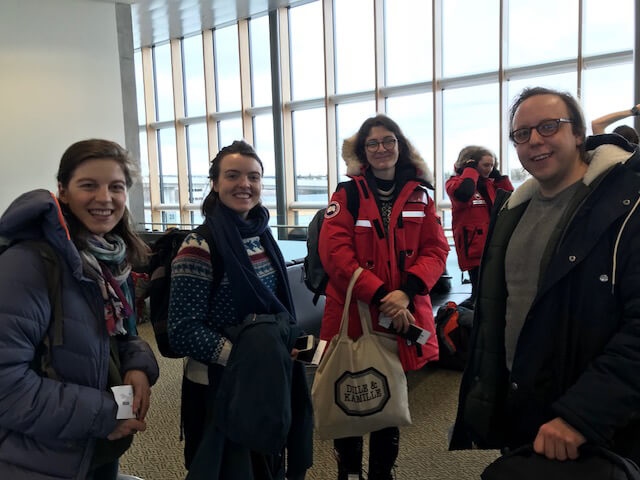
Happy faces heading to Iqaluit, Nunavut
One of the highlights of the day certainly was the icebreaker activity, where everybody had a chance to talk to others in a laid-back atmosphere. International and NAC students as well as our mentors and coordinators were able to get to know each other, find our footing and set our expectations as we embark on this amazing learning journey.
About the Sentinel North International Ph.D. Schools
As part of the Sentinel North training programs, the International Ph.D. Schools combine a practical approach in northern and/or highly technological environments with the opportunity to interact with high-profile scientists and experts. They provide international students with a chance to learn with world-class research infrastructure as well as specialists from various fields and domains.
This school is possible thanks to a key collaboration with the Nunavut Research Institute and the Nunavut Arctic College, and funding from the Canada First Research Excellence Fund.

